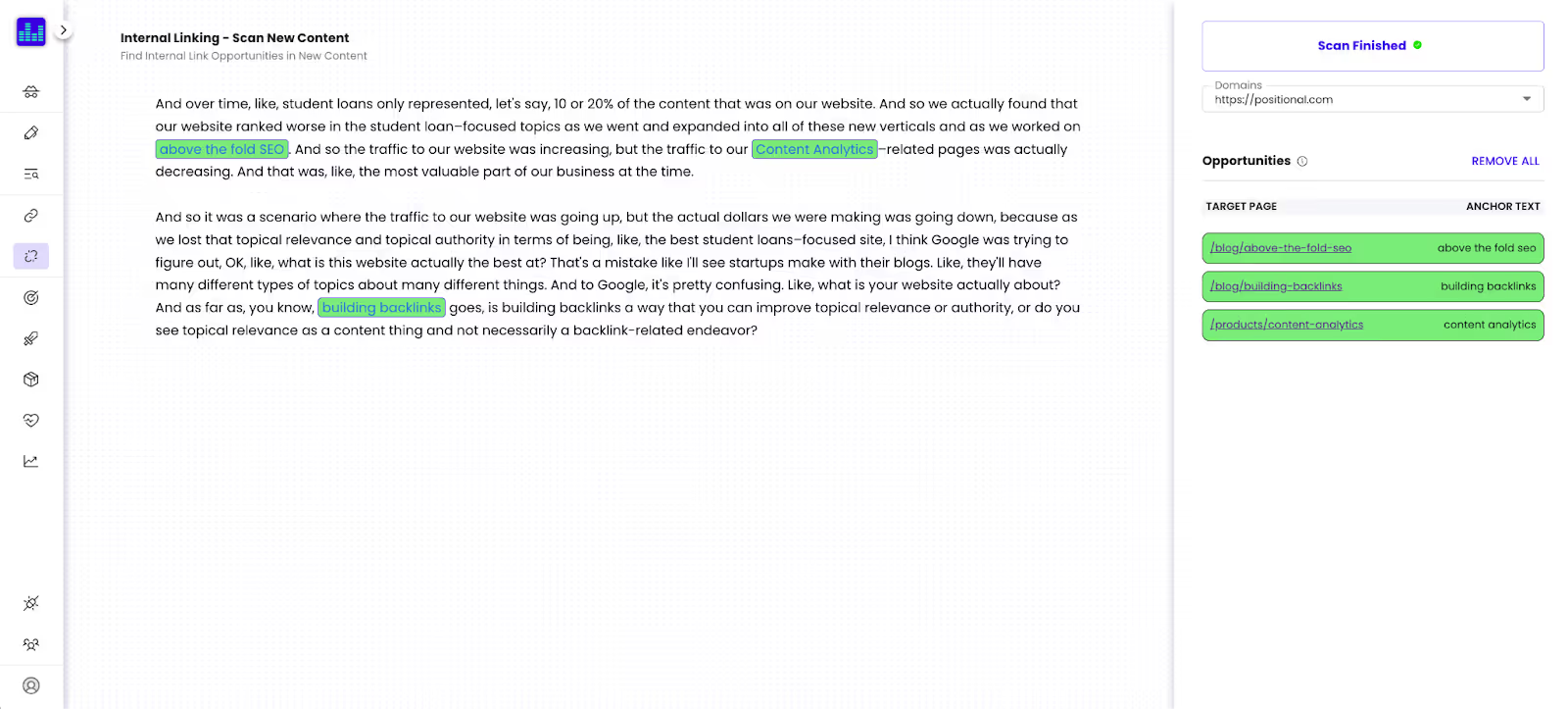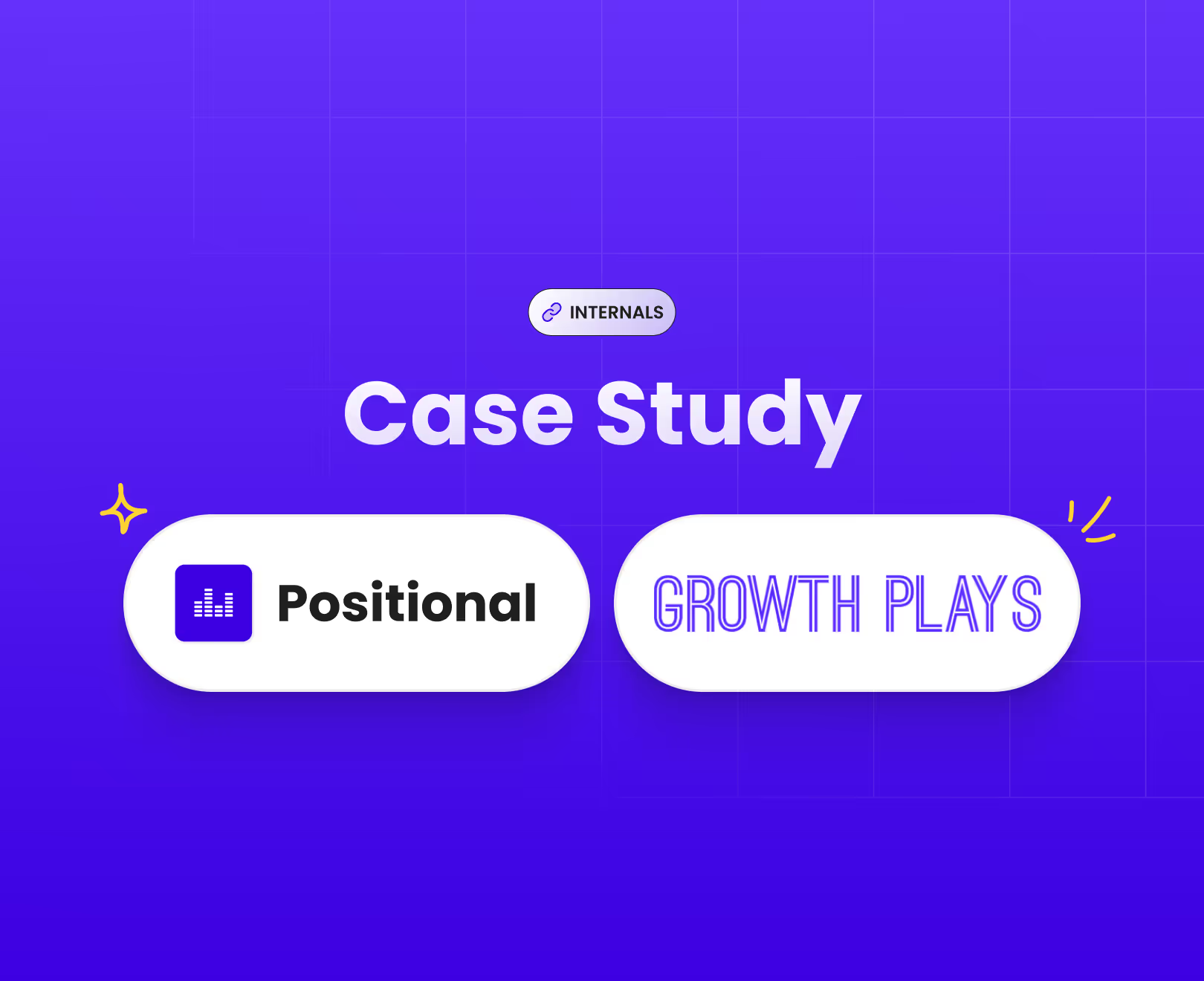Growth Plays is a leading content strategy and SEO agency that works exclusively with high-growth B2B technology companies. And the founder of Growth Plays, JH Scherck, is considered one of the best when it comes to ranking in high-competition SaaS categories. JH and his team at Growth Plays have worked with a number of leading B2B SaaS companies, including Lattice, Calendly, Heap, and LaunchDarkly.
An on-page SEO strategy is essential for the success of his clients’ organic search channels. And given that his clients typically already have fairly large and established websites, internal linking is critically important for shaping domain rankings and optimizing for longer-tail keywords.
However, due to the scale of these websites, implementing proper internal linking strategies used to take JH and his team countless hours each month — and a lot of good internal linking opportunities would still get missed. JH has found Positional’s Internals toolset extremely helpful for identifying internal link opportunities at scale.
“Internals saves us around five hours per month per customer. It’s not just about really saving time, though; it's about doing a better job internal linking than we were doing on our own,” he says.
The toolset has been so helpful that JH now uses Internals as part of his standard operating procedures when onboarding new clients, and he uses the tool monthly to identify new internal link opportunities in existing and new content.
Challenges
Growth Plays’ clients often have many thousands of pages formatted in a number of different ways. While internal linking to core pages and a small number of primary keywords is easy, JH and his team found it harder to identify internal link opportunities for secondary keywords or pages that were on the cusp of ranking really well and driving significant traffic.
In extreme cases, JH and his team were using “site: {keyword}” searches to find internal link opportunities across a large number of pages. We’ve all been there, and JH was there, too.
JH and his team also tried a number of other internal linking tools. However, they found that alternative solutions would:
- Create noise and identify outdated or untargeted suggestions
- Miss non-obvious internal link opportunities.
- Fail to understand the subtle differences between two similar but different pages on a website.
- Require technical integrations, forcing JH and his clients to spend significant time onboarding.
Solution and Benefits
After learning about Positional, a modern toolset for content marketing and SEO teams, Growth Plays made the decision to take advantage of Positional’s Internals toolset, which identifies missing internal link opportunities in existing and new content.

“The real value of Positional’s Internals toolset is that it shows us what we don’t know. Instead of having to go out and find internal link opportunities proactively, Positional’s Internals toolset finds those for us automatically. This is especially helpful for finding internal link opportunities on secondary keywords where we might be ranking moderately well, without proper internal linking, and are in striking distance,” says JH.
With Internals, onboarding is easy and doesn’t require any type of integration. (There is an optional and recommended GSC integration, but it isn’t required.) Simply add a new domain to the Internals toolset; Internals will pull in all the domain’s URLs from the sitemap or sitemaps. Internals then finds internal link opportunities in two unique ways:
Keyword Approach: Internals uses GSC query data alongside third-party keyword data to find and match internal link opportunities in existing content. For example, Internals will suggest internally linking to a target page if one of the target page’s ranked keywords is appearing on a source page, but no internal link is currently on that source page.
NLP Approach: Internals attempts to understand what your target pages are about and which keywords they should rank for. It then looks for those target keywords within the site’s existing pages, and suggests an internal link if there’s an opportunity and there isn’t already an internal link on the page.
“Internals then shows us where those internal links can be included on a page with a report that is pretty easy to review,” says JH when discussing the table report view that Positional provides. Users are able to filter and export internal linking suggestions, too.
Positional also has a manual scan view, which can be helpful for finding internal linking opportunities in a new piece of content.

Copy and paste the content into Positional’s Internals - Scan tool, and Positional’s Keyword Approach feature will provide internal link suggestions. Kiss “site: {keyword}” goodbye!
Using Positional
JH and his team have had quite a bit of success over the past few years, and today, they work with many clients. Using Positional, JH is able to add all of his clients to a single dashboard. The Growth Plays team is also able to rerun or recrawl any of the client sites at any point in time. “For us, it's a super valuable solution and one that we get a lot of value out of,” says JH.
Agencies are able to add multiple users to their Positional account and are able to export an unlimited number of reports from the toolset.
As a bonus, some agencies have found that adding prospective clients to Internals is helpful as a way to come to the table with specific internal linking suggestions before starting work — and this helps them win new business.
Positional offers a number of additional tools, including tools for keyword research, keyword tracking, content analytics, and content optimization. All are designed for scale and allow for the support of multiple clients and users.
Getting Started
Positional is currently in a private beta, and we’re gearing up for the public launch of our platform soon.
If you’re interested in taking advantage of discounted private beta pricing and access, you can schedule a demo with a member of our team. We’d love to show you around, and if you’d like, we’d be happy to come to the table with some internal linking suggestions for your website. Just drop a domain or two in the notes section of the Calendly booking.
Thank you, JH, for being an early supporter of Positional. Working with you and the entire Growth Plays team has been a pleasure!

